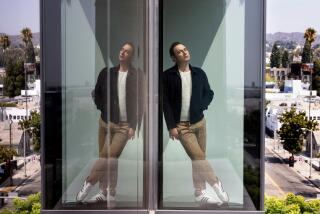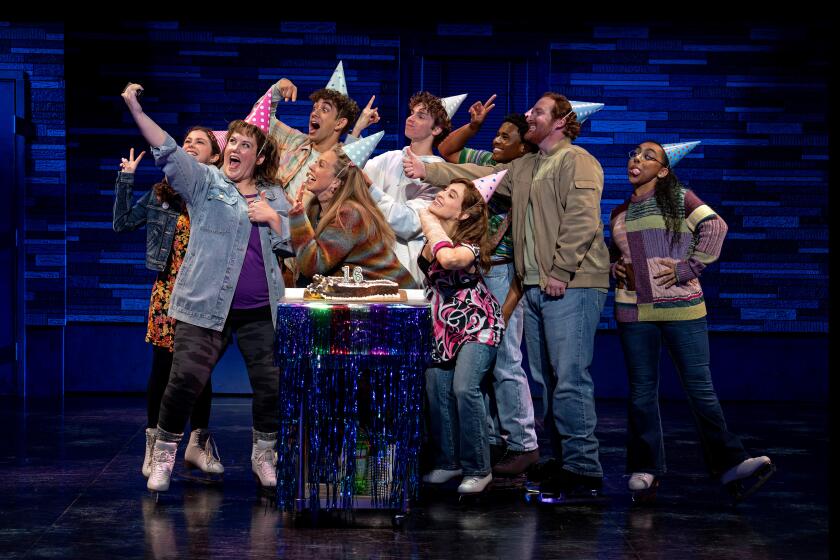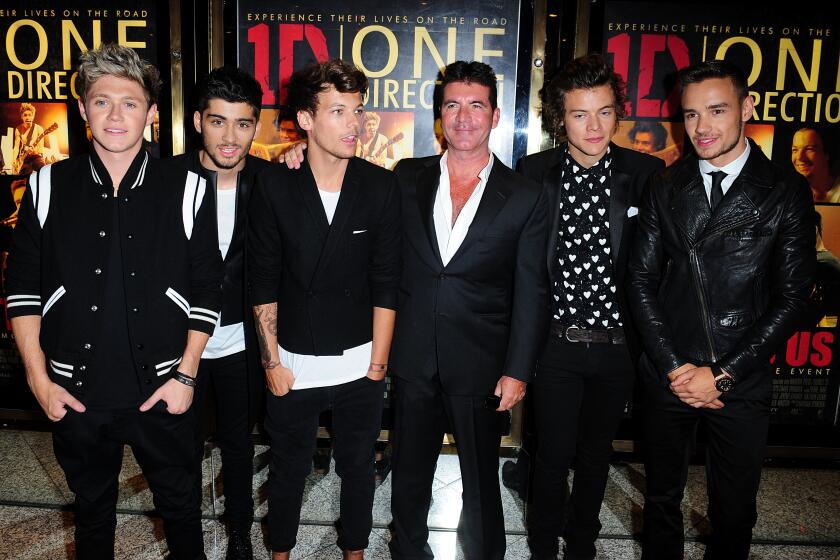AROUND THE GALLERIES
Ruby Neri’s painted clay figures and big, blazing paintings take visitors back to the heyday of German Expressionism. In the first decades of the 20th century, artists such as Franz Marc, Emil Nolde and Paula Modersohn Becker sought the crude truth in deliberately inelegant works that embraced childlike innocence, primitive vigor and the naked basics of life: pleasure and pain, love and death, food and sex.
But unlike all too many second-, third- and fourth-generation Expressionists, Neri does not use the ham-fisted simplicity of first-generation Expressionism as an excuse to work swiftly, freely and easily with the unselfconsciousness of an unschooled naif following her unsullied intuitions.
Instead, the 39-year-old artist gets past the superficial attractions of the often-imitated style by getting to its heart. The underlying structure of clashing colors and simple shapes controls its emotionalism. Her dazzling yet strangely subdued works marry the discipline of Formalism to the boldness of Expressionism, making for a union that is original and moving -- of the moment, and out of this world.
At the David Kordansky Gallery, Neri’s breakout exhibition features three bodies of work. Any one would make for a strong solo show.
First, four 6-by-5-foot paintings line the rear wall. Depicting figures kissing, riding horses, strolling under the stars and cavorting amid flowers, they create an awesome backdrop for the small and midsize sculptures that fill the main space with a riot of shiny reds, blues and yellows, set off by a rainbow of luxurious purples, screeching oranges, vibrating greens and lipstick pinks.
Next, on a row of 11 pedestals along the left wall, 11 stoneware pieces portray a sympathetic group of oddly endearing misfits. The size of tall vases or generous cookie jars, Neri’s weirdly captivating fusions of faces and vessels convey a wide range of demeanors, attitudes and personalities, whether grizzled fatigue or grumpy world-weariness; formidable determination or curiosity-crossed shyness; and dopey indecisiveness or profound self-doubt. Each of her potent visages is covered with an untraditional combination of glazes and paints, including oil, enamel, acrylic, tempera and ink.
Finally, eight larger sculptures, resting on low pedestals, are scattered around the middle of the gallery. Made of plaster slathered with oil paint, these pieces feature a single nude figure picking monstrous flowers, or pairs and groups of mostly nude figures walking, talking, lolling or standing stoically, like the guardians of ancient tombs or unspoken secrets.
The profound sense of patience they exude complements their vibrant, eye-grabbing colors. This gives them the depth and the resonance that provide long-lasting satisfactions.
--
David Kordansky Gallery, 3143 S. La Cienega Blvd., L.A., through Aug. 8. Closed Sundays and Mondays. (310) 558-3030, www.davidkordansky gallery.com.
--
‘Thunk’ delivers some artful funk
The five-artist exhibition “Thunk” at the Khastoo Gallery plays dumb with just the right touch of intelligence, bringing big ideas down to earth. Imagine the sound of a 26-volume encyclopedia hitting the ground after being tossed from the top of an ivory tower and you’ll get a feel for what this fun, free-form show is up to.
Just inside the front door, James Hyde’s “Big Beanbag” sets the intellect on a crash course with reality. The swollen blob of a sculpture, with a diameter of roughly 6 feet, resembles an oversize beanbag chair or a beach ball gone wrong. Made of linen and inflatable packaging material, Hyde’s lumpen abstraction is also a 3-D painting, its surface covered with untidy swipes of acrylic in an organic palette of overripe vegetables and creamy pastels. Hyde makes the misbegotten melange look unlovely yet sumptuous, a deflated ideal with its own funky spirit.
Jimmy Raskin’s “The [Documentarian’s] Return of the Drunken Boat” -- a cavalier stack of plywood, Styrofoam and cement festooned with party decorations, fake seashells and glittery streamers -- has the presence of a scarecrow made by a farmer who dreams of being a big-city set decorator. Its charms are barbed.
A pair of Rob Reynolds’ small, rainbow-shaped paintings in arcs of Ad Reinhardt black and disco-ball silver, counteracts the piecemeal funkiness with a sense of urbane restraint. His nearly 8-foot-square oil on canvas, “Untitled (Shadow #1),” gracefully glides from dark blue to even darker blue, showing how much can be done with very few elements.
Alex Olson does something similar in his delicious little paintings. The scribbled shapes in “Cleo” and “Correspondent” come off as being casual yet careful.
The master of transforming incidental gestures into art worth thinking about is Richard Tuttle. Two of his works, “White Snails 3” and “Untitled,” serve as the glue that holds “Thunk” together. Each is so simple that if your kid did it you wouldn’t give it a second thought. But Tuttle gets you to see a folded piece of paper, a couple of squiggles drawn in pencil or a few bits of tape with fresh eyes, as if each mundane mark were a universe with its own pedestrian, everyday beauty.
--
Khastoo Gallery, 7556 W. Sunset Blvd., L.A., (323) 472-6498, through next Friday. Closed Sunday through Tuesday. www.khastoo.com.
--
An unheeded generation
A fine little survey of Michael Goldberg’s paintings on canvas and paper from 1960 to 2003 gives a glimpse of the deep intelligence embodied by the furiously worked surfaces of the New Yorker’s abstractions. At the Manny Silverman Gallery, his 17 small- to large-scale paintings show an artist consistently succeeding in the struggle to wrestle the unexpected from gestures and techniques that increasingly ran the risk of degenerating into formulaic cliches.
Goldberg (1924-2007) belongs to one of the most misunderstood (and overlooked) groups of American painters: second-generation Abstract Expressionists. For decades, many historians have treated his works, along with those by Norman Bluhm, Alfred Leslie, Sam Francis and Joan Mitchell, as merely refining or polishing up the more ambitious paintings by their immediate predecessors, namely Jackson Pollock, Mark Rothko and Willem de Kooning.
Today, it’s clear that Goldberg demanded a lot more than that from painting and regularly got it. None of the works in his impressively diverse and wildly energized exhibition has the same tempo, rhythm, pulse or punch as another. Each is as raw and unscripted as a life lived on the edge, without a safety net or particularly detailed plan other than keeping it fresh. All go far out of their way to keep preciousness, facility and the artist’s inner being out of the picture.
Goldberg often blotted out large sections, scraped off freshly applied passages, scribbled over others and mechanically repeated basic shapes, creating inchoate patterns and striped, building blocks of fresh, unmixed colors. By putting some distance between his touch or his hand, he made works that anticipated much of the most engaging painting being made in the Digital Age, when cool detachment on the part of the artist allows for more heated passion on the part of viewers.
--
Manny Silverman Gallery, 619 N. Almont Drive, L.A., (310) 659-8256, through Aug. 22. Closed Sundays and Mondays. www.mannysilvermangallery .com.
--
His sculptures
are galvanized
On first glance, the four paintings, four sculptures and two drawings in Daniel Ruanova’s second solo show in L.A., “Fear Is God,” are about as ambiguous as razor-wire fences: Each screams its often foulmouthed message so loudly and clearly that listening closely seems to be beside the point.
But there’s more than that to the self-taught, Tijuana-born and -based artist’s exhibition at the Couturier Gallery. Regardless of whether the claim made by the title is true, the devil is in the details and well worth your undivided attention.
Ruanova’s abstract sculptures are more resonant than his paintings, which fail to get out from under the long shadows cast by Bruce Nauman’s similarly aggressive pictures of words, Andy Warhol’s camouflage patterns and Barbara Kruger’s point-blank statements.
Made from the same galvanized steel bars and stainless-steel rivets of the security fences being erected around homes and businesses all over Tijuana, Ruanova’s sculptures resemble industrial-strength tumbleweeds or the unlikely offspring of a Sol LeWitt sculpture and a security blockade. They also recall some of Richard Deacon’s quirky works, but without the organic sensuality or whimsical improvisation.
The angry angularity of the Italian Futurists and the whiplash frenzy of the English Vorticists lie behind Ruanova’s loaded pieces. Even so, the young artist’s indestructible sculptures still manage to stand on their own and be of the moment.
--
Couturier Gallery, 166 N. La Brea Ave., L.A., (323) 933-5557, through Aug. 1. Closed Sundays and Mondays. www .couturiergallery.com.
--
More to Read
The biggest entertainment stories
Get our big stories about Hollywood, film, television, music, arts, culture and more right in your inbox as soon as they publish.
You may occasionally receive promotional content from the Los Angeles Times.










